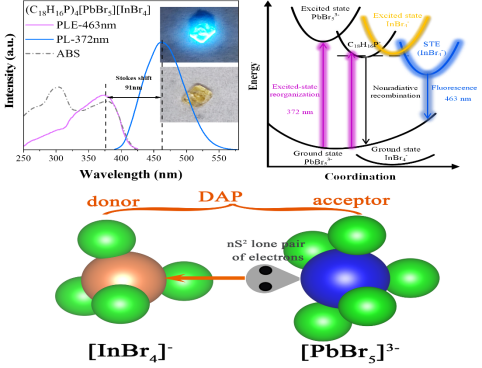Recently, The team of Professor Zou Bingsuo from SKL is entitled "Mixed B-site driven [InBr4]-tetrahedral efficient blueemission" was published in the Chemical Engineering Journal.

The [InX4]−tetrahedron is a structure with stronger rigidity than the [InX6]3−octahedron, which makes it a possible blue light emitting material. In this study, the method of mixed B-sites is used to control the polyhedral transition in the crystal structure. In3+ions partially replace Pb2+ions to form the mixed B sites of Pb-In. The electronegativity difference of both causes clear energy transfer between Pb and In. The movement of the electron cloud causes a change in the polyhedral structure, which promotes the formation of [PbBr5]3−pyramid and [InBr4]−tetrahedra. In this way, we have achieved the efficient blue light emission of [InBr4]−tetrahedron for the first time. Under 372 nm UV light excitation, (PPh3H)4[PbBr5][InBr4] can achieve efficient blue emission, the photoluminescence quantum yield is 74.03 %, and the emission center at 463 nm. The rigid environment and the [InBr4]−tetrahedron are the sources of the minor Stokes shift, and the self-trapping exciton of the zero dimensions [InBr4]−tetrahedron is the source of efficient blue light emission. Meanwhile, we found that there are two optical transition processes between [PbBr5]3−and [InBr4]−. One is the transfer from the excited state of [PbBr5]3−to the excited state of [InBr4]−, and triphenylphosphine acts as the energy transfer medium of the two. The other is the transfer from the ground state of [PbBr5]3−(donor) to the excited state of [InBr4]−(acceptor).